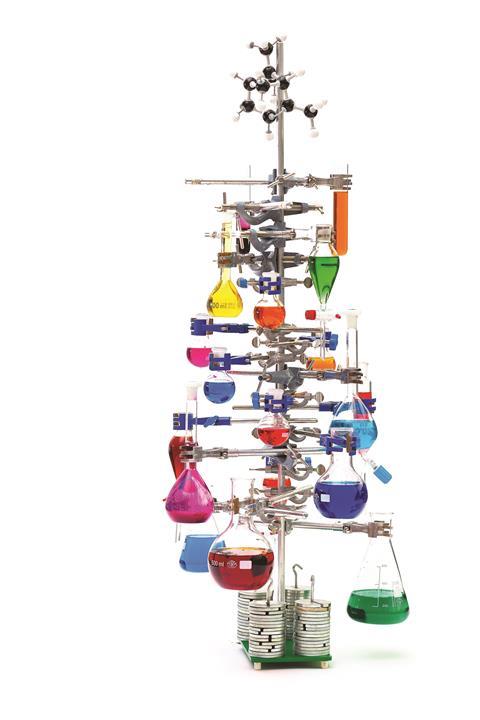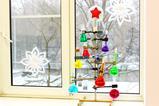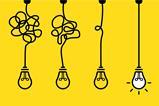The holidays are coming and with them the opportunity to use the traditional Christmas tree as a learning tool. Creating a chemistree is a task that students of all ages and levels can tackle

The concept of a chemistry-themed Christmas tree is well known among chemists but seemingly underappreciated as an educational opportunity. Despite this, many articles and images have been published that describe the concept as a lesson or demonstration. The earliest report I found was from 1940 by a high school in Michigan where students made a tree from ‘ring stands, rings, burette clamps and rubber tubing’ under the direction of their teacher, Wilamena Schnooberger. In 1956, A W Sturges from a high school in Iowa described the ‘chemical Christmas tree’ as a useful way to teach indicators and the nomenclature of equipment. Therefore it seems the chemical Christmas tree, or chemistree for short, may in fact have its origins in the school laboratory.
Here I have gathered some ideas for your chemistree. The complexity and design of your class’s chemistree can vary significantly, but the guidance you give your students can be tailored for various specifications.
Starter for ten
This type of chemistree is ideal for younger students with minimal practical chemistry experience. Traditionally it consists of a novelty Christmas tree decorated with ornaments that use a chemical theme, such as the periodic table, eg with hydrogen at the top and heavier elements at the bottom. This project can also be presented as a poster, with the elements arranged by their atomic radius or by using Bohr models as ornaments. Incorporating the elements into your chemistree this year is particularly relevant because 2019 is the International Year of the Periodic Table of the Chemical Elements and the 150th anniversary of Mendeleev’s table.
Find out more
Take a look at all our articles and resources about the periodic table of elements or visit our interactive periodic table, featuring history, alchemy, podcasts, videos and data trends.
Another lesson for this type of tree uses molecular model kits to teach valence-shell electron-pair repulsion theory. Various molecular geometry ‘ornaments’ can be used for decoration and the star on top of the tree consists of four inflated balloons tied together by their stems to make a tetrahedral shape.
Crystalise your ideas
Facilitated groups of students can grow their own chemistree by using different coloured solutions. This learning activity can be extended over a number of weeks in the lead-up to Christmas. You can now buy crystal chemistree kits in shops, but all the materials are readily available in most school labs. A simple example uses cardboard cut into the shape of a Christmas tree placed in a dish of supersaturated dipotassium phosphate (K2 HPO4) solution. Over half a day, the solution will rise up the cardboard tree and crystallise as a result of capillary action and evaporation, respectively. Green dye and other colours can be added to the tips of the cardboard tree to create coloured crystals as they form. Aluminium(III) potassium sulfate (KAl(SO4)2) or copper sulfate are also really good substances for growing crystals and you can use them as part of a crystal growing competition for the entire class.
Another excellent variation of the crystal tree comes from William Barron de Burgh. It uses two interconnected copper triangles in a solution of silver nitrate. Over a few hours, nanocrystals of silver will grow on the solid copper framework and it provides a great example of redox chemistry.

Colour me beautiful
Described as early as 1940, this version uses retort stands to form the trunk of the chemistree. Rubber tubing takes the place of tinsel garlands and glass wool substitutes for fake snow. Coloured solutions in flasks (usually round-bottomed) are clamped in place strategically to form an overall cone shape. Each of the clamps that protrude from the stand acts as the branches of the tree with the solutions representing the traditional ornaments. The coloured solutions usually consist of indicators, transition metal salts and other coloured substances commonly found in school labs.
Solutions have traditionally included: copper sulfate (blue), potassium permanganate (purple), methyl orange indicator in acid (red), methyl orange indicator in base (yellow), phenolphthalein in acid (pink), dilute bromine water (reddish-yellow), iodine in hexane (violet) and Benedict’s reagent or Fehling’s solution heated in the presence of reducing sugars (brick red). Universal indicator could also be used to achieve a full range of colours with solutions at different pH. As well as coloured solutions, the Tollens’ test (silver mirror) for the presence of aldehydes over ketones can also be used. When done in a clean round-bottom flask instead of a test tube, it can be an impressive addition to your Christmas creation. Please remember safety: depending on the chemicals used the chemistree may need to be stored in a fume cupboard.
Trip the light fantastic
Traditional fairy lights are usually the favourite, however some creative chemistry can be incorporated. Photoreactive plastic beads, both the UV type and the glow-in-the-dark type, can be strung together and wrapped around the chemistree. The beads are impregnated with a photoreactive dye, which undergoes a molecular rearrangement when exposed to light. A slightly more exotic demonstration shows students an example of chemiluminescence. When luminol reacts with hydrogen peroxide it produces a fantastic blue glow, albeit short-lived. Luminol is normally used for crime scene analysis to detect blood residues and the reaction is another great example of redox chemistry.
Finally, what you use for the top of the tree is up to you, but a star can be fashioned from clay triangles, some funnels or a benzene ring molecular model. My personal favourites are angels made from filter paper or an image of Marie Curie with a ‘radioactive’ green halo!
Next-generation chemistree
Over recent years the chemical Christmas tree has moved from the school lab into the research lab with intriguing results, often featured on social media with the hashtag #chemistree. New forms of this seasonal creation include nanoscale, fluorescence, 3D laser etching, X-ray crystal structures and computational chemistry virtual images. As the technology available to chemists improves, I’m sure chemists will evolve the concept of the chemistree still further.
For the last decade I have organised an informal social-media competition for the best chemistree. This year’s competition launches on 1 December with the theme of ‘The periodic table’. The winners will be announced on Twitter on 21 December. To join the fun, simply post a picture of your chemistree creation with the hashtag #chemistree on Twitter or Instagram.
This article describes the building of chemistrees for all age groups. Chemistrees can be as simple or as complex as you like. They introduce students to lab equipment and concepts.
Set up the lab or classroom with the items that students can use and challenge them to incorporate the chemistry they’ve learned to date. Example decorations include sticking photos of chemists to the inside of petri dishes; growing copper sulfate crystals in petri dishes and placing LEDs behind them for different colours; and making colour solutions using various indicators in acids and bases. Showing students examples on social media with the hashtag #chemistree can spur their creativity.
Acknowledgements
Special thanks to Ger O’Donovan of Regina Mundi College, William Barron de Burgh of Dame Elizabeth Cadbury School and to the many teachers who inspired some of the ideas here and those who continue to inspire students by making chemistry fun!
References
- W Schnooberger, J. Chem. Educ., 1940, 17, 593 (DOI: 10.1021/ed017p593)
- A W Sturges, J. Chem. Educ., 1956, 33, 626 (DOI: 10.1021/ed033p626)
- S Murov, J. Chem. Educ., 1994, 71, 1082 (DOI: 10.1021/ed071p1082)
- J H Lechner,J. Chem. Educ., 1994, 71, 1021 (DOI: 10.1021/ed071p1021)















1 Reader's comment